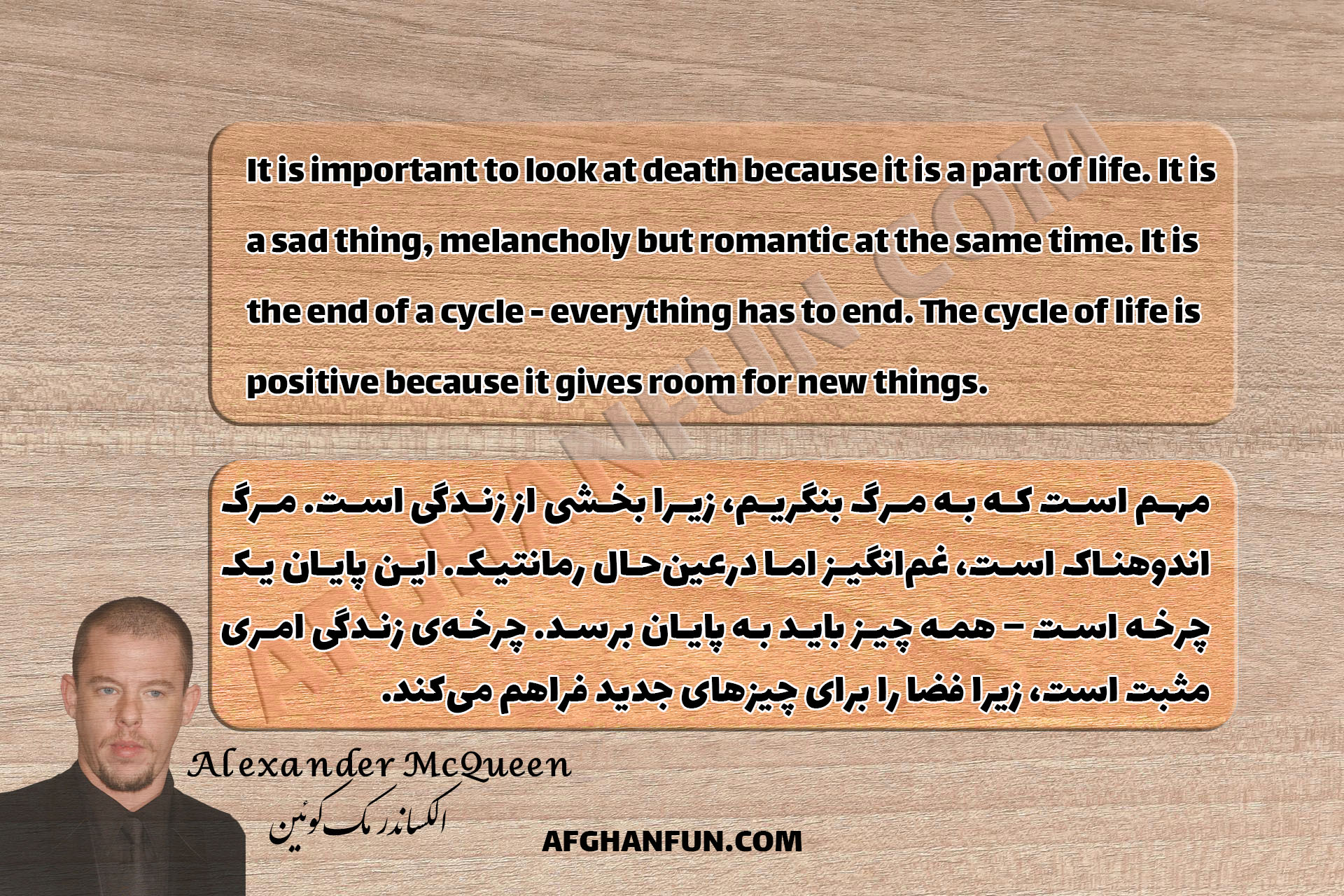Alexander McQueen: The Beauty in Endings
It is important to look at death because it is a part of life. It is a sad thing, melancholy but romantic at the same time. It is the end of a cycle – everything has to end. The cycle of life is positive because it gives room for new things.
Alexander McQueen
Finding Positivity in Endings: A Quote by Alexander McQueen
مهم است که به مرگ بنگریم، زیرا بخشی از زندگی است. مرگ اندوهناک است، غمانگیز اما درعینحال رمانتیک. این پایان یک چرخه است – همه چیز باید به پایان برسد. چرخهی زندگی امری مثبت است، زیرا فضا را برای چیزهای جدید فراهم میکند.
الکساندر مککوئین
این نقل قول به چرخهی طبیعی زندگی و مرگ اشاره دارد و نشان میدهد که مرگ، هرچند غمانگیز، بخشی اجتنابناپذیر از زندگی است. مرگ پایان یک مرحله است اما در عین حال راه را برای چیزهای جدید باز میکند. این دیدگاه، رویکردی فلسفی و حتی شاعرانه به مرگ دارد، که آن را نه فقط یک فقدان، بلکه عاملی برای تغییر و دگرگونی در نظر میگیرد. این تفسیر میتواند به پذیرش مرگ بهعنوان بخشی از طبیعت کمک کند و نگاه ما را از ترس و غم به درک عمیقتری از زندگی تغییر دهد.
What Alexander McQueen Understood About Life and Death
Муҳим аст, ки ба марг назар кунем, зеро он як қисми зиндагӣ аст. Он ғамангез аст, дилгиркунанда, вале ҳамзамон ошиқона. Ин анҷоми як давра аст – ҳар чиз бояд ба поён расад. Давраи зиндагӣ мусбат аст, зеро барои чизҳои нав ҷой медиҳад.
Александр Маккуин
Ин иқтибос ба даври табиии зиндагӣ ва марг ишора мекунад ва нишон медиҳад, ки марг, ҳарчанд ғамангез бошад, қисми ҷудонашавандаи ҳаёт аст. Марг анҷоми як марҳила аст, аммо ҳамзамон барои чизҳои нав роҳ мекушояд. Ин назар фалсафӣ ва ҳатто шоирона ба марг аст, ки онро на танҳо ҳамчун талафот, балки ҳамчун омили тағйир ва навсозӣ медонад. Ин тафсир метавонад ба қабули марг ҳамчун қисми табиат кӯмак кунад ва диди моро аз тарсу ғам ба дарки амиқтари зиндагӣ тағйир диҳад.
Alexander McQueen Quotes: Reflections on the Life and Death Cycle
من المهم أن ننظر إلى الموت لأنه جزء من الحياة. إنه أمر محزن، كئيب ولكنه رومانسي في نفس الوقت. إنه نهاية دورة – كل شيء لا بد أن ينتهي. دورة الحياة إيجابية لأنها تفسح المجال لأشياء جديدة.
ألكسندر ماكوين
يُشير هذا الاقتباس إلى الدورة الطبيعية للحياة والموت، ويؤكد أن الموت، رغم كونه حزينًا، هو جزء لا مفر منه من الحياة. إنه يُمثل نهاية مرحلة ولكنه في الوقت نفسه يفسح المجال للأشياء الجديدة. هذه الرؤية تُعطي بُعدًا فلسفيًا وحتى شاعريًا للموت، حيث لا يُنظر إليه فقط كفقدان، بل كعامل للتغيير والتجديد. يمكن لهذا التفسير أن يُساعد في تقبل الموت كجزء من الطبيعة، وتحويل نظرتنا إليه من الخوف والحزن إلى فهم أعمق للحياة.
Alexander McQueen’s quote reflects a nuanced and philosophical perspective on death, blending melancholy with a sense of beauty and inevitability. Let’s break it down:
- “It is important to look at death because it is a part of life.”
McQueen begins with a pragmatic acknowledgment of death as an intrinsic element of human existence. This suggests a belief that confronting mortality, rather than avoiding it, is essential to understanding life fully. It aligns with existential ideas that awareness of death can sharpen one’s appreciation of living. - “It is a sad thing, melancholy but romantic at the same time.”
Here, he juxtaposes contrasting emotions—sadness and romance—which is a hallmark of his aesthetic as a designer known for blending the dark and the beautiful. The “melancholy” evokes a deep, reflective sorrow, while “romantic” hints at an idealized or poetic view of death, perhaps as a dramatic or transformative moment. This duality mirrors his work, where beauty often emerges from the macabre. - “It is the end of a cycle – everything has to end.”
McQueen frames death as a natural conclusion, emphasizing its universality and inevitability. The cyclical imagery suggests a worldview rooted in nature or seasons—something that ends not in finality but as part of a larger rhythm. This could reflect his interest in life’s impermanence, a theme often explored in his fashion collections. - “The cycle of life is positive because it gives room for new things.”
The quote ends on an optimistic note, portraying death as a generative force. By clearing space for “new things,” McQueen implies renewal or rebirth, turning a potentially nihilistic view into one of possibility. It’s a subtle nod to resilience and creation, resonating with his own relentless innovation in design.
Overall, this quote encapsulates McQueen’s complex relationship with life and death—a mix of stark realism, emotional depth, and a creative lens that finds meaning in endings. It’s less about despair and more about acceptance, tinged with his signature gothic romanticism. This perspective likely informed his art, where themes of mortality (like his famous skull motifs) were not just morbid but celebratory of life’s fleeting nature.
Alexander McQueen, born Lee Alexander McQueen on March 17, 1969, in Lewisham, London, was one of the most visionary and provocative fashion designers of his generation. Known for his extraordinary creativity, technical mastery, and unapologetic exploration of dark and beautiful themes, McQueen redefined fashion as an art form, blending theatricality with raw emotion. His work often transcended clothing, becoming a medium to explore life, death, nature, and the human condition.
Early Life and Rise to Fame
McQueen grew up in a working-class family, the youngest of six children, with a taxi-driver father and a teacher mother who encouraged his fascination with history and art. He left school at 16 and began his career as an apprentice on Savile Row, London’s famed tailoring district. There, he honed his skills in pattern-cutting and construction, working for firms like Anderson & Sheppard and Gieves & Hawkes. This foundation in traditional tailoring became a cornerstone of his later avant-garde designs, allowing him to deconstruct and reinvent garments with precision.
After Savile Row, McQueen studied at Central Saint Martins, earning a master’s degree in fashion design in 1992. His graduate collection, titled Jack the Ripper Stalks His Victims, caught the eye of stylist Isabella Blow, who purchased it in its entirety and became his mentor. The collection—dark, daring, and steeped in Victorian gothic—set the tone for his career, signaling his refusal to conform to fashion’s softer norms.
Career and Creative Vision
McQueen launched his eponymous label in 1992, quickly gaining a reputation as fashion’s enfant terrible. His early shows, like Highland Rape (1995) and The Birds (1995), shocked audiences with their raw energy and controversial themes—colonialism, violence, and sexuality—paired with impeccable craftsmanship. Critics accused him of misogyny, but McQueen countered that his work empowered women by celebrating their strength and complexity, not just their fragility.
In 1996, at just 27, he was appointed creative director of Givenchy, succeeding John Galliano. Though his tenure there (until 2001) was marked by tension—he famously called the house’s heritage “irrelevant”—it showcased his ability to balance commercial demands with his renegade spirit. Meanwhile, his own label flourished, producing iconic collections like No. 13 (1999), where a model in a white dress was spray-painted live by robots, and Plato’s Atlantis (2010), a futuristic meditation on evolution and climate change that debuted Lady Gaga’s “Bad Romance.”
McQueen’s runway shows were legendary, less like fashion presentations and more like performance art. He drew inspiration from history, nature, and his own psyche—think models walking through water (Voss, 2001) or emerging from a glass asylum. His recurring motifs—skulls, corsets, feathers, and taxidermy—reflected an obsession with life’s impermanence, often tied to his belief, as he once said, that “everything has to end.”
Personal Struggles and Legacy
Behind the brilliance, McQueen battled personal demons. He was open about his struggles with depression, drug use, and the pressures of fame. The death of Isabella Blow in 2007 and his mother, Joyce, in 2010 devastated him. On February 11, 2010, days after his mother’s passing and on the eve of her funeral, McQueen took his own life at age 40. His death sent shockwaves through the fashion world, leaving behind a legacy that felt tragically incomplete yet profoundly influential.
Posthumously, his brand has thrived under Sarah Burton, who softened his edge while preserving his essence—most notably with Kate Middleton’s 2011 royal wedding dress. The 2011 Savage Beauty exhibition at the Metropolitan Museum of Art became one of the museum’s most visited shows, cementing his status as a cultural icon.
McQueen’s Philosophy
McQueen saw fashion as a mirror to society and the self. His quote—“It is important to look at death because it is a part of life”—encapsulates his worldview: unflinching, romantic, and cyclical. He didn’t shy away from the macabre; he embraced it, finding beauty in decay and strength in vulnerability. This duality made him a polarizing figure but also a genius who challenged conventions and inspired countless designers.
Alexander McQueen wasn’t just a designer—he was a storyteller, a provocateur, and a poet in cloth. His work remains a testament to the power of art to confront, heal, and transcend, proving that even in endings, there’s room for something new.
External Links:
Alexander McQueen’s biography on biography website.
Alexander McQueen on Wikipedia











